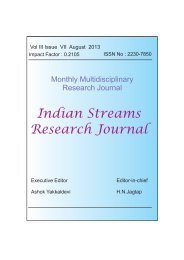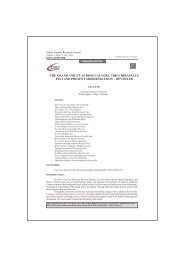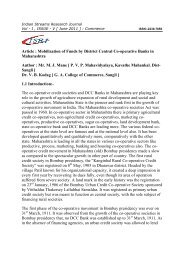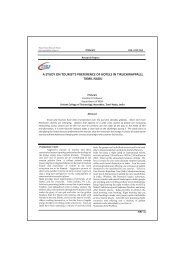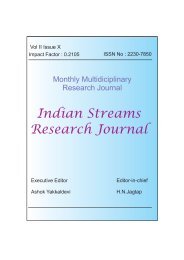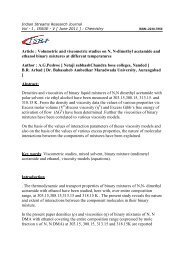Literaty Response To Partition In Pakistan Raju Jayasing Patole
Literaty Response To Partition In Pakistan Raju Jayasing Patole
Literaty Response To Partition In Pakistan Raju Jayasing Patole
You also want an ePaper? Increase the reach of your titles
YUMPU automatically turns print PDFs into web optimized ePapers that Google loves.
<strong>In</strong>dian Streams Research Journal ISSN 2230-7850<br />
Volume-3, Issue-6, July-2013<br />
<strong>Literaty</strong> <strong>Response</strong> <strong>To</strong> <strong>Partition</strong> <strong>In</strong> <strong>Pakistan</strong><br />
<strong>Raju</strong> <strong>Jayasing</strong> <strong>Patole</strong><br />
Abstract:There were writers who migrated to <strong>Pakistan</strong>, simply because they were Muslims. Some of them were<br />
prejudiced and took up the pen to show the cruelties perpetrated by Sikhs and Hindus. Others, who were not from<br />
<strong>Pakistan</strong>, revealed a deep nostalgia for a state where Hindus and Muslims had dwelt peacefully together until the<br />
coming of <strong>Partition</strong>.<br />
Keyword: <strong>Literaty</strong> <strong>Response</strong> , <strong>Partition</strong> , history , civilization.<br />
INTRODUCTION<br />
Sadat Hasan Manto (1912-1955), one of the most<br />
famous (and controversial, too!) Urdu short story writer<br />
migrated to <strong>Pakistan</strong> and wrote number of all-time classic<br />
short stories on <strong>Partition</strong> violence irrespective of religion or<br />
gender. His Urdu short stories are the most important<br />
<strong>Partition</strong> Narratives. Unlike the other <strong>Pakistan</strong>i Urdu or<br />
English writers, Manto never takes sides, nor does he try to<br />
assert his newly- acquired “<strong>Pakistan</strong>i nationality /identity,<br />
nor does he color the <strong>Partition</strong> violence as Hindu, Muslim or<br />
Sikh. Siyah Hashiye, Khol Do, Thanda Gosht, and <strong>To</strong>ba Tek<br />
Singh are just few examples of his all- time classic <strong>Partition</strong><br />
stories. Qurratulain Hyder's Aar Ka Dairyman (1948)<br />
showed how interwoven the lives of Hindus and Muslims<br />
had been before <strong>Partition</strong>. The book reveals with rare<br />
intensity and immense sweep the experience of <strong>Partition</strong> that<br />
was a murderous attack on the millennial continuum of<br />
<strong>In</strong>dian history and civilization. However what is striking<br />
about this novel is that though it focuses on nostalgia and loss<br />
as the aftermath of <strong>Partition</strong>, <strong>Partition</strong> itself is dismissed in a<br />
chapter of simply two words: Hindostan-1947. Twice once in<br />
Aag Ka Dariya and again in Akhri Shab ke Humsafar<br />
translated as Fireflies <strong>In</strong> The Mist she writes about the years<br />
before and after <strong>Partition</strong>, but chooses to remain silent about<br />
the <strong>Partition</strong> years. <strong>In</strong>terestingly, Qurratulain Hyder's Aag<br />
Ka Dariya (The River of Fire) falls in the category of<br />
<strong>Pakistan</strong>i novels simply by accident she is sitting in Karachi<br />
where she had migrated from <strong>In</strong>dia. <strong>In</strong>stead of a <strong>Pakistan</strong>i<br />
ideology, she projects the bewilderment of a migrant who<br />
finds herself in another land quite by chance. Her other<br />
Novel Mere Bhi Sanamkhane (My Temples <strong>To</strong>o”)<br />
published in 1947, was able to capture the anguish of a group<br />
in Lucknow whose dream of a United <strong>In</strong>dia was shattered by<br />
the grim and tragic happenings in 1946-47”what was there<br />
for them to celebrate at the fateful midnight hour or at the<br />
dawn of <strong>In</strong>dependence” Similarly, in a preface to Raqs-i<br />
–Iblis: <strong>In</strong>qilab 47 Ki Ek Khuchukan Dastan (The Dance of<br />
the Devil: A Grisly Story of Uprising of 47) (1950), M.<br />
Aslam makes it clear that he is writing the novel to reflect the<br />
cruelty of Sikhs towards Muslims. However, despite the<br />
several stories of Hindus and Sikhs cruelties to Muslim-this<br />
partisan novel does not show Muslim cruelty to Hindus or<br />
Sikhs –Aslam suggests that, even in the midst of the horrors<br />
and madness of <strong>Partition</strong>, individual friendships cross<br />
religious divides. Naseem Hejazy's Khak aur Khun (Ashes<br />
and Blood, 1949) is a far more moderate book than Raqs-i<br />
Iblis, but it too shares the author's partisan attitude towards<br />
Muslims and <strong>Pakistan</strong>. Like Raqs-i- Iblis, Khak aur Khoon<br />
stresses the treachery of the Hindus and Congress. It is<br />
motivated by the same anti-<strong>In</strong>dia/Hindu feeling as is Raqs-i-<br />
Iblis. Unlike Manto, who described the atrocities on both<br />
sides and showed that, when it came to cruelty, neither<br />
Muslims nor Hindus differed from each other, Aslam is intent<br />
on showing how Hindus and Sikhs barring a couple are the<br />
villains of the period. Abdullah Hussain, who also does not<br />
show Muslim atrocities, blurs the perpetrators of violence.<br />
Thus though Hussain describes the attacks on the caravans<br />
and the abduction, it is almost reluctantly that he does so<br />
Abdullah Husain's Udas Naslein (1962) shows a similar<br />
antipathy towards described the event of <strong>Partition</strong>. <strong>In</strong> <strong>In</strong>tizar<br />
Husain's novel Basti (1979) the 'witness figure' is a historian,<br />
who looks back to 1947, in the wake of the 1971 break-up of<br />
<strong>Pakistan</strong>, and the failure of the ideals that animated the<br />
<strong>Pakistan</strong> movement. Urdu novelists such as Abdullah<br />
Hussain in Udas Naslein and M. Aslam in Raqs-i- Iblis show,<br />
like faiz, the failure of <strong>Pakistan</strong> to live up to its promise.<br />
Mumtaz Shah Nawaz in 'The Heart Divided' (1957)<br />
showed friendships and love affairs that existed among<br />
Hindus and Muslims before the coming of 1947 <strong>Partition</strong><br />
tore them apart. But neither Hyper nor Shah Nawaz depicts<br />
atrocities. While Shah Nawaz suggests that the Hindu<br />
Congress betrayed the Muslims, she is more inspired by the<br />
idea of <strong>Pakistan</strong> as a land of promise rather than as a place<br />
where Muslims had to go because of atrocities and<br />
communal attacks on them by non-Muslim. Meanwhile it is<br />
not just the Urdu novelist writing shortly after <strong>Partition</strong> who<br />
feels the need to explain <strong>Partition</strong> and justify it on political<br />
and religious grounds. It is striking that Bapsi Sidhwa and<br />
Mahmud Sipra (both NRPs-Non-Resident <strong>Pakistan</strong>is) both<br />
so different in background and temperament, should both<br />
have begun their first novels with a description of a train<br />
massacre. Sipra's `Pawn to King Three' (1965) includes a<br />
vignette of Jinnah and explains his role in encouraging<br />
<strong>Pakistan</strong>i Businessman. <strong>In</strong> Bapsi Sidhwa's `Ice-Candy-Man'<br />
1<br />
<strong>Literaty</strong> <strong>Response</strong> <strong>To</strong> <strong>Partition</strong> <strong>In</strong> <strong>Pakistan</strong><br />
<strong>Raju</strong> <strong>Jayasing</strong> <strong>Patole</strong>
<strong>In</strong>dian Streams Research Journal ISSN 2230-7850<br />
Volume-3, Issue-6, July-2013<br />
Chemistry Museum: An inevitable phenomenon in<br />
education<br />
Bajirao B. Ahire<br />
(1988), the narrator Lenny, muses about the absurdity of the<br />
<strong>Partition</strong> of the <strong>In</strong>dian sub –continent. <strong>Partition</strong> made people<br />
aware of their religious differences as Lenny says, “And I<br />
became aware of religious difference. It is sudden. One day<br />
everybody is themselves – and the next day they are Hindus,<br />
Muslim, Sikh, Christian. People shrink, dwindling into<br />
symbols” Religious identification did not stop there.<br />
Unfortunately, after <strong>Partition</strong>, the Need for identity, ethnic,<br />
linguistic, religious. Seems to become even more acute. If<br />
we examine the writings of Sidhwa and Sipra we see that, in<br />
the need to establish their credentials as <strong>Pakistan</strong>i writer, they<br />
both begin with the <strong>Partition</strong> and with the event which has<br />
become the symbol for the <strong>Partition</strong> in Punjab: the train<br />
massacre, which represented group action and senseless<br />
killing. At the same time, despite their difference, they both<br />
stress a more positive side to Jinnah than reflected in other<br />
writing from the sub-continent –though, recently (1990) both<br />
Shish Tharoor in 'The Great <strong>In</strong>dian Novel' (1989) and Mukul<br />
kasavan in 'Looking Through Glass' (1995) depict a more<br />
sympathetic treatment of Jinnah. Sidhwa's another novel,<br />
`The Bride` (1963), as she told several people, was inspired<br />
by the story of a tribal woman who had been killed by her<br />
husband because of infidelity. This is another aspect of social<br />
history of <strong>Partition</strong> Horror killing. It prevailed on a wide<br />
scale during <strong>Partition</strong> days, especially among Hindus and<br />
Sikhs. This concept necessitates a gendered/feminist<br />
historiography of <strong>Partition</strong> of the sub-continent. <strong>In</strong> 'Ice-<br />
Candy-Man', Sidhwa strengthens her <strong>Pakistan</strong> identity even<br />
further by bringing in the <strong>In</strong>dian atrocities, committed in the<br />
Punjab, and by reappraising the character of Jinnah and<br />
attempting to improve this image, stress that the British<br />
supported the <strong>In</strong>dians and were deliberately unfair to both<br />
<strong>Pakistan</strong> and Jinnah. However Sidhwa rises above petty<br />
nationalism. 'Ice-Candy-Man' does not stress the two-nation<br />
theory behind the creation of <strong>Pakistan</strong>. <strong>In</strong> other words,<br />
Sidhwa does not stress the belief of <strong>Pakistan</strong>i Muslims of the<br />
necessity of <strong>Partition</strong> and the creation of <strong>Pakistan</strong>. <strong>In</strong> fact,<br />
'Ice-Candy- Man' suggests that religious and cultural<br />
difference are artificially created and deliberately fostered.<br />
<strong>In</strong> 'The Bride', Sidhwa recognizes the inhumanity that<br />
accompanies communal violence, but also suggests the need<br />
to ask for forgiveness and to give it. Unlike other <strong>Partition</strong><br />
novelists and short-story writers, sideway refuses to let<br />
women remain victims. Using the motif of rape and<br />
abduction associated with <strong>Partition</strong>, she again refuses to<br />
allow the raped woman to be discarded.<br />
The new generation of <strong>Pakistan</strong>i writers differs from the<br />
older ones on the two-nation theory. Mehr Nigar Masroor,<br />
another <strong>Pakistan</strong>i novelist, asked that her book` Shadows of<br />
Time` (1987) be printed in <strong>In</strong>dia. Though the <strong>Pakistan</strong>i<br />
identity is obvious, the writer insists that human<br />
relationships, personal ties between people of different<br />
religions, cannot be denied. At the end, the narrator rejects<br />
<strong>Pakistan</strong>, not the <strong>Pakistan</strong> that has been initially created, but<br />
the fundamentalist <strong>Pakistan</strong> that it had turned into “ She ties<br />
in historical events with her narrative juxtaposing history and<br />
fiction” Masroor, too, like Sidhwa, points out that Jinnah was<br />
pragmatic. What she sees as wrong was not <strong>Partition</strong>, but the<br />
direction that <strong>Pakistan</strong> took after the early death of Jinnah,<br />
One of the chief differences perhaps between <strong>In</strong>dian and<br />
<strong>Pakistan</strong>i novels on the <strong>Partition</strong> is that despite all the sadness<br />
in <strong>In</strong>dian novels, there tends to be a sense of euphoria<br />
attendant on independence. This is not always so in<br />
<strong>Pakistan</strong>i novels. Though Mumtaz Shah Nawaz's novel,<br />
'The Heart Divided' ends on an optimistic note, she avoids<br />
the partition itself.<br />
REFERENCE:<br />
i. “<strong>Partition</strong> Literature: A Study of <strong>In</strong>tizar Hussain”, Modern<br />
Asian Studies, vol. 14, No.3, 1980, pp.370-410<br />
ii. Zaman , op.cit., p.279<br />
iii.Manto's life and historical evaluation of his <strong>Partition</strong><br />
stories.<br />
iv. As quoted in Hasan Anders Bjorn, <strong>Partition</strong> and Genocide:<br />
Manifestation of Violence in Punjab 1937-1947 (New Delhi:<br />
<strong>In</strong>dia Research Press, 2002), p.1<br />
v. Ritu Menon and Kamla Bhasin in Borders and Boundaries,<br />
op. cit., and by Urvashi Butalia in The Other Side of Silence:<br />
Voices from the <strong>Partition</strong> of <strong>In</strong>dia, (New Delhi: Penguin<br />
<strong>In</strong>dia, 1998).<br />
2




